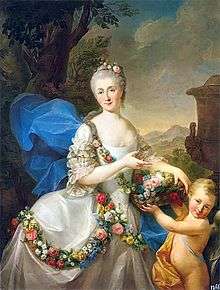Stanisław Poniatowski (1754–1833)
| His Grace Prince Stanisław Poniatowski | |
|---|---|
|
| |
| Grand Treasurer of Lithuania | |
|
In office 1784–1791 | |
| Monarch | Stanisław II Augustus |
| Preceded by | Michał Brzostowski |
| Succeeded by | Ludwik Skumin Tyszkiewicz |
| Personal details | |
| Born |
November 23, 1754 Warsaw, Polish-Lithuanian Commonwealth |
| Died |
February 13, 1833 (aged 78) Florence, Italy |
| Nationality | Polish |
| Spouse(s) | Cassandra Luci |
| Mother | Apolonia Ustrzycka |
| Father | Kazimierz Poniatowski |
Prince Stanisław Poniatowski (November 23, 1754 – February 13, 1833) was a Polish nobleman, politician, diplomat, a member of the wealthy Poniatowski family and a nephew of the last king of Poland, Stanisław II Augustus.[1] He was the official Commander of the Royal Foot Guards regiment directly responsible for the monarch's life as well as the Grand Treasurer of the Grand Duchy of Lithuania (1784–1791) and Governor of Stryj, which made him a key figure in Poland during the Age of Enlightenment.
Biography
Stanisław was the son of Prince Kazimierz Poniatowski (September 15, 1721 – 1800), a Polish nobleman, Deputy Chamberlain of Lithuania (1742–1773), Commander of the Royal Army and a Knight of the prestigious Order of the White Eagle, awarded on August 3, 1744 in Warsaw. His father was the brother of the last King of Poland and Grand Duke of Lithuania, Stanisław II Augustus, who saw in his nephew a possible successor and heir to the throne of the Polish-Lithuanian Commonwealth. Both, Kazimierz and the monarch were born from Konstancja Czartoryska, (January 29, 1700 – October 27, 1759), in-laws of the Polish-Lithuanian Czartoryski philo-Russian family.
Stanisław Poniatowski became the Knight of the Order of the White Eagle on December 8, 1773. Very well educated and particularly interested in the finances and economy of the country, as well as the arts, Poniatowski was not a very popular figure among the nobility, the so-called szlachta, who perceived him as being arrogant and competitive. He commissioned about 2500 engraved precious gems to a group of gem-engravers in Rome who turned to Classical literature for inspiration. In 1830, Poniatowski published a summary catalogue of his gems, Catalogue des Pierres Gravees Antiques de S.A. le Prince Stanislas Poniatowski, which contained elaborate descriptions. His collection was sold after his death at a Christie's auction in 1839 and has been dispersed ever since.[2]
Following the Partitions of Poland, Poniatowski emigrated to Italy, where he lived in Rome, and then in Florence. He is the ancestor of the present members of the Poniatowski family bearing the title of Fürst Poniatowski or Principe Poniatowski di Monterotondo. Some sources state that he married Cassandra Luci (Rome, 1785 - Florence, 1863) in 1806,[3] but apparently that has never occurred as she was married to Vicenzo Venturini Benloch. Among his descendants are the Princes Poniatowski of the Empire of Austria and Counts and the Princes of Monterotondo in the Grand Duchy of Tuscany:
- Isabella Luci (Rome, 1806 - Florence, 1896), married firstly in January/February 1821 to Count Prospero Bentivoglio (- 1821), without children, and secondly in 1822 to Count Zanobi di Ricci (- October 16, 1844). Then, she married Marquess Filippo De Piccolellis.
- Carlo Luci (Rome, 1808 - Florence, 1887), later Poniatowski, legitimized in 1847, made Conte di Monterotondo by the Grand Duke of Tuscany on November 20, 1847, Principe di Monterotondo by the Grand Duke of Tuscany and Prince Poniatowski by the Emperor of Austria both on November 19, 1850 (Rome, August 4, 1808 - San Pancrazio, July 23, 1887), married in Florence, September 21, 1831 to Elisa Napoleone Montecatini (Lucca, November 4, 1808 - Lucca, April 18, 1893), without children.
- Costanza Luci (Rome, 1811 - Florence, 1851), married to Count Daniele Zappi.
- Giuseppe Michele Saverio Francesco Giovanni Luci [4](Rome, February 21, 1816 - London, July 4, 1873), later known as Józef Michał Poniatowski, legitimized in 1847, made Conte di Monterotondo by the Grand Duke of Tuscany on November 20, 1847, Principe di Monterotondo by the Grand Duke of Tuscany and Prince Poniatowski by the Emperor of Austria both on November 19, 1850.[5] He was a composer and a singer, and was sent to Paris as plenipotentiary by Grand Duke of Tuscany Leopold II. In 1834, he married Countess Matilda Perotti (1814 - February 1875) in Florence, and they had one son, Stanislaus August Friedrich Joseph Telemach Luci.
- Michele Luci (Rome, 1816 - Florence, 1864), founder of Imparziale fiorentino.
Gallery
 Apolonia Ustrzycka and her son, by Marcello Bacciarelli
Apolonia Ustrzycka and her son, by Marcello Bacciarelli Prince Stanisław Poniatowski
Prince Stanisław Poniatowski Portrait of Stanisław Poniatowski, by Angelica Kauffman, 1786
Portrait of Stanisław Poniatowski, by Angelica Kauffman, 1786 Cassandra Luci
Cassandra Luci Costanza Luci
Costanza Luci Isabella Luci
Isabella Luci Carlo, Giuseppe and Michele Luci-Poniatowski
Carlo, Giuseppe and Michele Luci-Poniatowski
References
- ↑ Encyclopædia Britannica, 1911, p. 61
- ↑ http://www.beazley.ox.ac.uk/gems/poniatowski/default.htm
- ↑ The Nathaniel Hawthorne review, Vol. 22, II, Nathaniel Hawthorne Society, Hawthorne-Longfellow Library, 1996, p. 32
- ↑ "Poniatowski Family". Genealogy.eu. Retrieved January 12, 2010.
- ↑ W. L. Hubbard, The American History and Encyclopedia of Music, p. 168
Bibliography
- AA.VV, Polonia-Italia: relazioni artistiche dal medioevo al XVIII secolo, Polska Akademia Nauk Stacja Naukowa w Rzymie, Zakład Narodowy imienia Ossolińskich, 1979
- The Encyclopædia Britannica: a dictionary of arts, sciences, literature and general information, Vol. 22, 1911, p. 61.
- Jerzy Jan Lerski; Piotr Wróbel; Richard J. Kozicki (1996). Historical Dictionary of Poland, 966–1945. Greenwood Publishing. p. 464.
| Wikimedia Commons has media related to Stanisław Poniatowski. |